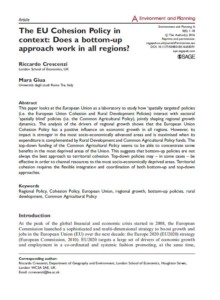 Riccardo Crescenzia e Mara Giuab, The EU Cohesion Policy in context: Does a bottom-up approach work in all regions? Environment and Planning A (2016), 52(1): 134–152.
Riccardo Crescenzia e Mara Giuab, The EU Cohesion Policy in context: Does a bottom-up approach work in all regions? Environment and Planning A (2016), 52(1): 134–152.
Published online before print July 12, 2016, doi: 10.1177/0308518X16658291
a London School of Economics
b Università degli studi Roma Tre
Abstract
This paper looks at the European Union as a laboratory to study how ‘spatially targeted’ policies (i.e. the European Union Cohesion and Rural Development Policies) interact with sectoral ‘spatially blind’ policies (i.e. the Common Agricultural Policy), jointly shaping regional growth dynamics. The analysis of the drivers of regional growth shows that the European Union Cohesion Policy has a positive influence on economic growth in all regions. However, its impact is stronger in the most socio-economically advanced areas and is maximised when its expenditure is complemented by Rural Development and Common Agricultural Policy funds. The top-down funding of the Common Agricultural Policy seems to be able to concentrate some benefits in the most deprived areas of the Union. This suggests that bottom-up policies are not always the best approach to territorial cohesion. Top-down policies may – in some cases – be effective in order to channel resources to the most socio-economically deprived areas. Territorial cohesion requires the flexible integration and coordination of both bottom-up and top-down approaches.
Keywords: Regional Policy, Cohesion Policy, European Union, regional growth, bottom-up policies, rural development, Common Agricultural Policy


